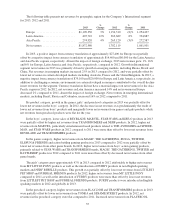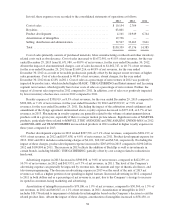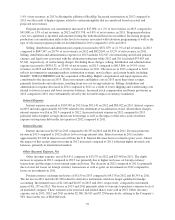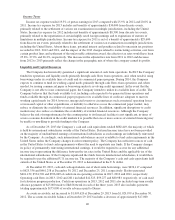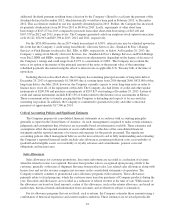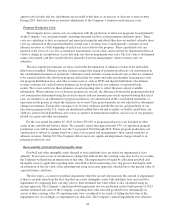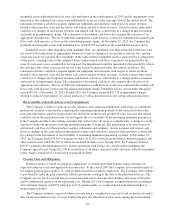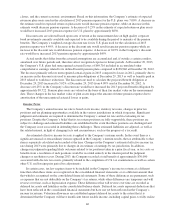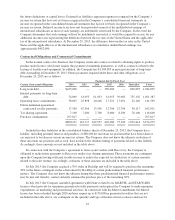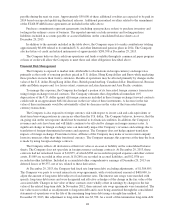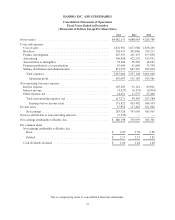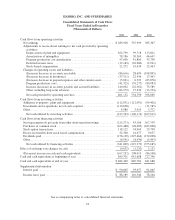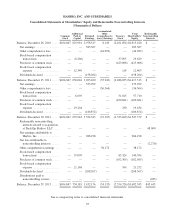Hasbro 2013 Annual Report Download - page 57
Download and view the complete annual report
Please find page 57 of the 2013 Hasbro annual report below. You can navigate through the pages in the report by either clicking on the pages listed below, or by using the keyword search tool below to find specific information within the annual report.
intangible assets with indefinite lives were also performed in the fourth quarter of 2013 and no impairments were
indicated as the estimated fair values were substantially in excess of the carrying value of the related assets. The
estimation of future cash flows requires significant judgments and estimates with respect to future revenues
related to the respective asset and the future cash outlays related to those revenues. Actual revenues and related
cash flows or changes in anticipated revenues and related cash flows could result in a change in this assessment
and result in an impairment charge. The estimation of discounted cash flows also requires the selection of an
appropriate discount rate. The use of different assumptions would increase or decrease estimated discounted cash
flows and could increase or decrease the related impairment charge. At December 29, 2013, the Company has
goodwill and intangible assets with indefinite lives of $670,059 recorded on the consolidated balance sheets.
Intangible assets, other than those with indefinite lives, are amortized over their estimated useful lives and
are reviewed for indications of impairment whenever events or changes in circumstances indicate the carrying
value may not be recoverable. Recoverability of the value of these intangible assets is measured by a comparison
of the assets’ carrying value to the estimated future undiscounted cash flows expected to be generated by the
asset. If such assets were considered to be impaired, the impairment would be measured by the amount by which
the carrying value of the asset exceeds its fair value based on estimated future discounted cash flows. The
estimation of future cash flows requires significant judgments and estimates with respect to future revenues
related to the respective asset and the future cash outlays related to those revenues. Actual revenues and related
cash flows or changes in anticipated revenues and related cash flows could result in a change in this assessment
and result in an impairment charge. The estimation of discounted cash flows also requires the selection of an
appropriate discount rate. The use of different assumptions would increase or decrease estimated discounted cash
flows and could increase or decrease the related impairment charge. Intangible assets covered under this policy
were $300,261 at December 29, 2013. During 2013, the Company incurred $19,736 in impairment charges
relating to reduced expectations for certain products as well as the decision to exit certain other product lines.
Recoverability of Royalty Advances and Commitments
The Company’s ability to earn-out royalty advances and contractual obligations with respect to minimum
guaranteed royalties is assessed by comparing the remaining minimum guaranty to the estimated future sales
forecasts and related cash flow projections to be derived from the related product. If sales forecasts and related
cash flows from the particular product do not support the recoverability of the remaining minimum guaranty or,
if the Company decides to discontinue a product line with royalty advances or commitments, a charge to royalty
expense to write-off the non-recoverable minimum guaranty is required. The preparation of revenue forecasts
and related cash flows for these products requires judgments and estimates. Actual revenues and related cash
flows or changes in the assessment of anticipated revenues and cash flows related to these products could result
in a change to the assessment of recoverability of remaining minimum guaranteed royalties. At December 29,
2013, the Company had $294,991 of prepaid royalties, $152,459 of which are included in prepaid expenses and
other current assets and $142,532 of which are included in other assets. During 2013, the Company incurred
$20,851 related to the amendment of its’ license agreement with Zynga. As a result of this settlement, the
Company agreed to pay Zynga $12,500 in satisfaction of all future required royalty advances, with the remainder
of the charge comprised of a write-down of prepaid royalties.
Pension Costs and Obligations
Pension expense is based on actuarial computations of current and future benefits using estimates for
expected return on assets and applicable discount rates. At the end of 2007 the Company froze benefits under its
two largest pension plans in the U.S., with no future benefits accruing to employees. The Company will continue
to pay benefits under the plan consistent with the provisions existing at the date of the plan benefit freeze. The
Company uses its fiscal year-end date as its measurement date to measure the liabilities and assets of the plans
and to establish the expense for the upcoming year. During 2013, the Company recognized pension curtailment
and settlement charges of $6,993 related to its U.S. pension plans as a result of headcount reductions due to
restructuring activities.
The Company estimates expected return on assets using a weighted average rate based on historical market
data for the investment classes of assets held by the plan, the allocation of plan assets among those investment
45


